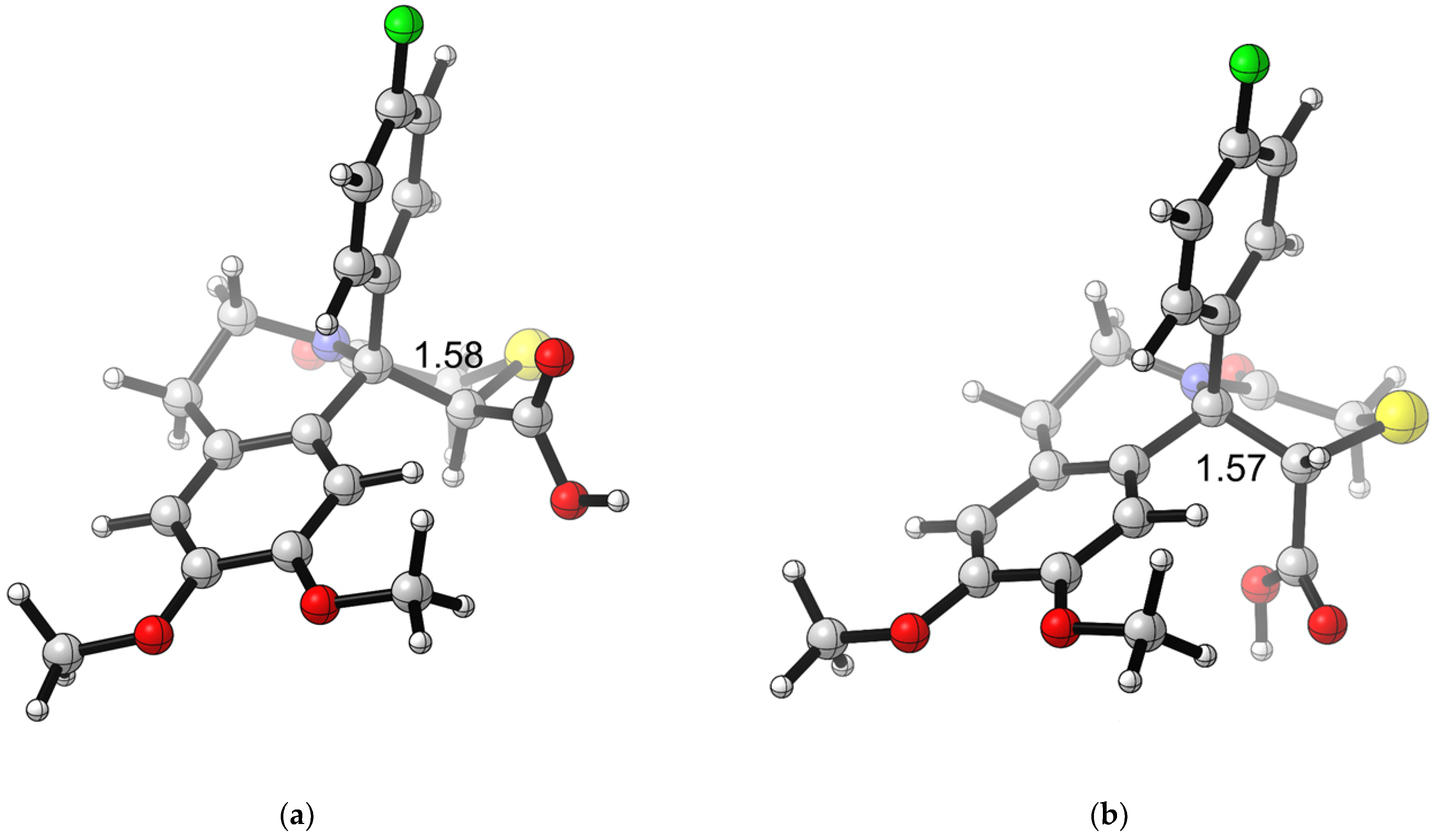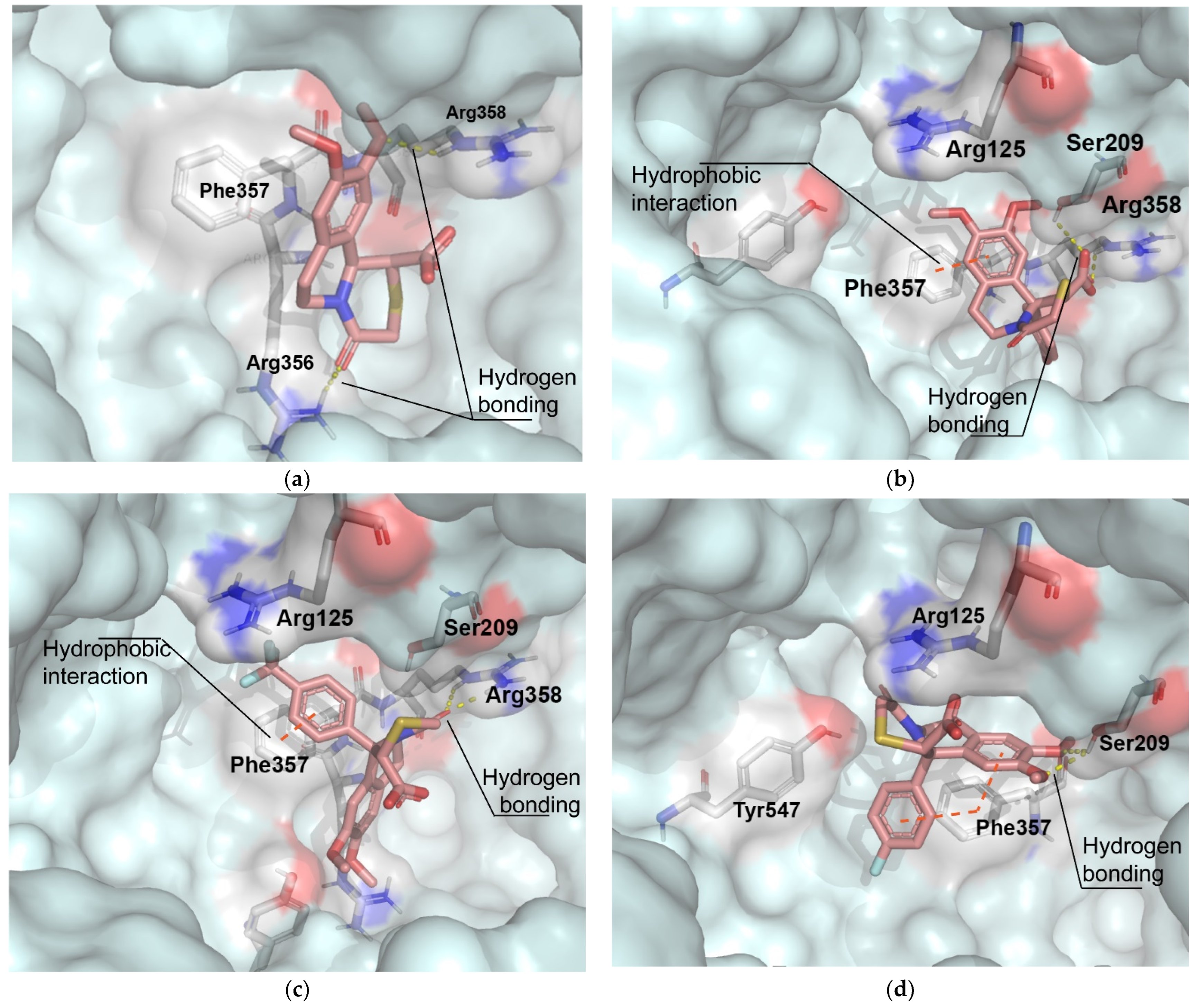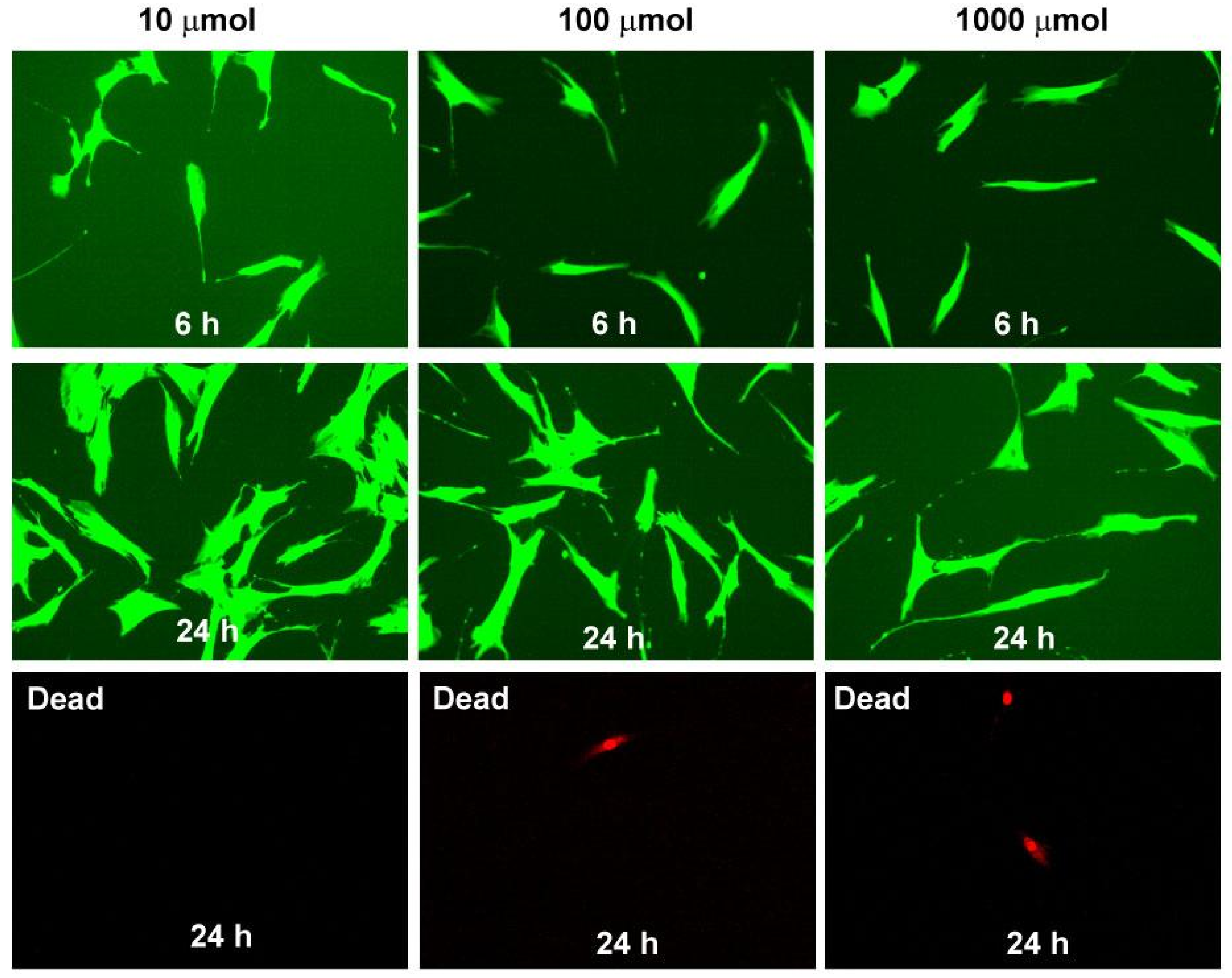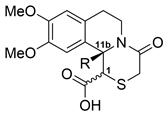Angular-Substituted [1,4]Thiazino[3,4-a]Isoquinolines: Biological Evaluation and In Silico Studies on DPP-IV Inhibition
Abstract
1. Introduction
2. Results
2.1. DPP-IV Inhibitory Activity
2.2. Geometry Optimization
2.3. Docking Analysis
2.4. Acute Toxicity Assay
3. Discussion
4. Materials and Methods
4.1. Synthesis of Target Compounds 4a–g
4.2. DPP-IV Inhibitory Assay
4.3. Molecular Docking
4.4. Cytotoxicity Analysis
5. Conclusions
Supplementary Materials
Author Contributions
Funding
Institutional Review Board Statement
Informed Consent Statement
Data Availability Statement
Acknowledgments
Conflicts of Interest
References
- Engel, M.; Hoffmann, T.; Wagner, L.; Wermann, M.; Heiser, U.; Kiefersauer, R.; Huber, R.; Bode, W.; Demuth, H.-U.; Brandstetter, H. The crystal structure of dipeptidyl peptidase IV (CD26) reveals its functional regulation and enzymatic mechanism. Proc. Natl. Acad. Sci. USA 2003, 100, 5063. [Google Scholar] [CrossRef] [PubMed]
- Augustyns, K.; Veken, P.V.d.; Senten, K.; Haemers, A. The Therapeutic Potential of Inhibitors of Dipeptidyl Peptidase IV (DPP IV) and Related Proline-Specific Dipeptidyl Aminopeptidases. Curr. Med. Chem. 2005, 12, 971–998. [Google Scholar] [CrossRef] [PubMed]
- Ahrén, B.; Simonsson, E.; Larsson, H.; Landin-Olsson, M.; Torgeirsson, H.; Jansson, P.-A.; Sandqvist, M.; Båvenholm, P.; Efendic, S.; Eriksson, J.W.; et al. Inhibition of Dipeptidyl Peptidase IV Improves Metabolic Control Over a 4-Week Study Period in Type 2 Diabetes. Diabetes Care 2002, 25, 869–875. [Google Scholar] [CrossRef] [PubMed]
- Pei, Z. From the bench to the bedside: Dipeptidyl peptidase IV inhibitors, a new class of oral antihyperglycemic agents. Curr. Opin. Drug Discov. Devel. 2008, 11, 512–532. [Google Scholar]
- Stephen, L.G., II. Medicinal Chemistry Approaches to the Inhibition of Dipeptidyl Peptidase IV. Curr. Top Med. Chem. 2008, 8, 1545–1552. [Google Scholar] [CrossRef]
- Mukhtar, Y.; Galalain, A.; Yunusa, U. A modern overview on diabetes mellitus: A chronic endocrine disorder. Eur. J. Biol. 2020, 5, 1–14. [Google Scholar] [CrossRef]
- Seino, Y.; Fukushima, M.; Yabe, D. GIP and GLP-1, the two incretin hormones: Similarities and differences. J. Diabetes Investig. 2010, 1, 8–23. [Google Scholar] [CrossRef]
- Baggio, L.L.; Drucker, D.J. Biology of Incretins: GLP-1 and GIP. Gastroenterology 2007, 132, 2131–2157. [Google Scholar] [CrossRef]
- Ahrén, B. Emerging dipeptidyl peptidase-4 inhibitors for the treatment of diabetes. Expert Opin. Emerg. Drugs 2008, 13, 593–607. [Google Scholar] [CrossRef]
- Scheen, A.J. DPP-4 inhibition and COVID-19: From initial concerns to recent expectations. Diabetes Metab. 2021, 47, 101213. [Google Scholar] [CrossRef]
- Yang, Y.; Zhao, L.; Wang, Y.; Liu, C.; Ke, T. Effects of novel glucose-lowering drugs on the COVID-19 patients with diabetes: A network meta-analysis of clinical outcomes. Int. J. Diabetes Dev. Ctries. 2024, 44, 426–436. [Google Scholar] [CrossRef]
- Kalyani, P.; Manash Pratim, P.; Riya, S.; Urvashee, G.; Ratna Jyoti, D.; Pompy, P.; Partha Pratim, K.; Smita, B.; Jyotirmoy, D.; Himangshu, S.; et al. Therapeutic Repurposing of Antidiabetic Drugs in Diabetes-associated Comorbidities. Curr. Drug Ther. 2024, 19, 178–194. [Google Scholar] [CrossRef]
- Havale, S.H.; Pal, M. Medicinal chemistry approaches to the inhibition of dipeptidyl peptidase-4 for the treatment of type 2 diabetes. Bioorg. Med. Chem. 2009, 17, 1783–1802. [Google Scholar] [CrossRef] [PubMed]
- Liu, Y.; Hu, Y.; Liu, T. Recent Advances in Non-Peptidomimetic Dipeptidyl Peptidase 4 Inhibitors: Medicinal Chemistry and Preclinical Aspects. Curr. Med. Chem. 2012, 19, 3982–3999. [Google Scholar] [CrossRef] [PubMed]
- Mehanna, A. Antidiabetic agents: Past, present and future. Future Med. Chem. 2013, 5, 411–430. [Google Scholar] [CrossRef]
- Juillerat-Jeanneret, L. Dipeptidyl Peptidase IV and Its Inhibitors: Therapeutics for Type 2 Diabetes and What Else? J. Med. Chem. 2014, 57, 2197–2212. [Google Scholar] [CrossRef]
- Liu, Y.; Hu, Y. Novel DPP-4 inhibitors against diabetes. Future Med. Chem. 2014, 6, 793–808. [Google Scholar] [CrossRef]
- Guo, Y.-Y.; Zhang, J.-Y.; Sun, J.-F.; Gao, H. A comprehensive review of small-molecule drugs for the treatment of type 2 diabetes mellitus: Synthetic approaches and clinical applications. Eur. J. Med. Chem. 2024, 267, 116185. [Google Scholar] [CrossRef]
- Shao, D.-W.; Zhao, L.-J.; Sun, J.-F. Synthesis and clinical application of representative small-molecule dipeptidyl Peptidase-4 (DPP-4) inhibitors for the treatment of type 2 diabetes mellitus (T2DM). Eur. J. Med. Chem. 2024, 272, 116464. [Google Scholar] [CrossRef]
- Singhal, S.; Manikrao Patil, V.; Verma, S.; Masand, N. Recent advances and structure-activity relationship studies of DPP-4 inhibitors as anti-diabetic agents. Bioorganic Chem. 2024, 146, 107277. [Google Scholar] [CrossRef]
- Kushwaha, R.N.; Haq, W.; Katti, S.B. Discovery ot 17 Gliptins in 17-years of Research for the treatment of Type 2 Diabetes: A Synthetic Overview. Chem. Biol. Interface 2014, 4, 137–162. [Google Scholar]
- Deacon, C.F.; Lebovitz, H.E. Comparative review of dipeptidyl peptidase-4 inhibitors and sulphonylureas. Diabetes Obes. Metab. 2016, 18, 333–347. [Google Scholar] [CrossRef] [PubMed]
- Kumar, S.; Mittal, A.; Mittal, A. A review upon medicinal perspective and designing rationale of DPP-4 inhibitors. Bioorganic Med. Chem. 2021, 46, 116354. [Google Scholar] [CrossRef] [PubMed]
- Boehringer, M.; Fischer, H.; Hennig, M.; Hunziker, D.; Huwyler, J.; Kuhn, B.; Loeffler, B.M.; Luebbers, T.; Mattei, P.; Narquizian, R.; et al. Aryl- and heteroaryl-substituted aminobenzo[a]quinolizines as dipeptidyl peptidase IV inhibitors. Bioorg. Med. Chem. Lett. 2010, 20, 1106–1108. [Google Scholar] [CrossRef]
- Mattei, P.; Boehringer, M.; Di Giorgio, P.; Fischer, H.; Hennig, M.; Huwyler, J.; Koçer, B.; Kuhn, B.; Loeffler, B.M.; MacDonald, A.; et al. Discovery of carmegliptin: A potent and long-acting dipeptidyl peptidase IV inhibitor for the treatment of type 2 diabetes. Bioorg. Med. Chem. Lett. 2010, 20, 1109–1113. [Google Scholar] [CrossRef]
- Lübbers, T.; Böhringer, M.; Gobbi, L.; Hennig, M.; Hunziker, D.; Kuhn, B.; Löffler, B.; Mattei, P.; Narquizian, R.; Peters, J.-U.; et al. 1,3-Disubstituted 4-aminopiperidines as useful tools in the optimization of the 2-aminobenzo[a]quinolizine dipeptidyl peptidase IV inhibitors. Bioorg. Med. Chem. Lett. 2007, 17, 2966–2970. [Google Scholar] [CrossRef]
- Pashev, A.; Burdzhiev, N.; Stanoeva, E. One-step route to tricyclic fused 1,2,3,4-tetrahydroisoquinoline systems via the Castagnoli–Cushman protocol. Beilstein J. Org. Chem. 2020, 16, 1456–1464. [Google Scholar] [CrossRef]
- Pashev, A.; Burdzhiev, N.; Stanoeva, E. Novel angularly substituted [1,4]thiazino[3,4-a]isoquinoline carboxylic acids prepared by cyclic imine-cyclic anhydride reaction. J. Heterocycl. Chem. 2023, 60, 513–518. [Google Scholar] [CrossRef]
- Frisch, M.J.; Trucks, G.W.; Schlegel, H.B.; Scuseria, G.E.; Robb, M.A.; Cheeseman, J.R.; Scalmani, G.; Barone, V.; Petersson, G.A.; Nakatsuji, H.; et al. Gaussian 16 Rev. A.03; Gaussian Inc.: Wallingford, CT, USA, 2016. [Google Scholar]
- Klamt, A.; Moya, C.; Palomar, J. A Comprehensive Comparison of the IEFPCM and SS(V)PE Continuum Solvation Methods with the COSMO Approach. J. Chem. Theory Comput. 2015, 11, 4220–4225. [Google Scholar] [CrossRef]
- Abud, A.P.R.; Zych, J.; Reus, T.L.; Kuligovski, C.; de Moraes, E.; Dallagiovanna, B.; Aguiar, A.M.d. The use of human adipose-derived stem cells based cytotoxicity assay for acute toxicity test. Regul. Toxicol. Pharmacol. 2015, 73, 992–998. [Google Scholar] [CrossRef]
- Fritsche, E.; Haarmann-Stemmann, T.; Kapr, J.; Galanjuk, S.; Hartmann, J.; Mertens, P.R.; Kämpfer, A.A.M.; Schins, R.P.F.; Tigges, J.; Koch, K. Stem Cells for Next Level Toxicity Testing in the 21st Century. Small 2021, 17, 2006252. [Google Scholar] [CrossRef] [PubMed]
- Ojeda-Montes, M.J.; Gimeno, A.; Tomas-Hernández, S.; Cereto-Massagué, A.; Beltrán-Debón, R.; Valls, C.; Mulero, M.; Pujadas, G.; Garcia-Vallvé, S. Activity and selectivity cliffs for DPP-IV inhibitors: Lessons we can learn from SAR studies and their application to virtual screening. Med. Res. Rev. 2018, 38, 1874–1915. [Google Scholar] [CrossRef] [PubMed]
- Vo, D.-V.; Hong, K.H.; Lee, J.; Park, H. Synthesis, in vitro evaluation, and computational simulations studies of 1,2,3-triazole analogues as DPP-4 inhibitors. Bioorganic Med. Chem. 2021, 29, 115861. [Google Scholar] [CrossRef] [PubMed]
- Fuh, M.-T.; Tseng, C.-C.; Li, S.-M.; Tsai, S.-E.; Chuang, T.-J.; Lu, C.-H.; Yang, Y.-C.; Tsai, H.J.; Wong, F.F. Design, synthesis and biological evaluation of glycolamide, glycinamide, and β-amino carbonyl 1,2,4-triazole derivatives as DPP-4 inhibitors. Bioorganic Chem. 2021, 114, 105049. [Google Scholar] [CrossRef]
- Ali, Z.; Akhtar, M.J.; Haider, M.R.; Khan, A.A.; Siddiqui, A.A.; Yar, M.S. Design and synthesis of quinazoline-3,4-(4H)-diamine endowed with thiazoline moiety as new class for DPP-4 and DPPH inhibitor. Bioorganic Chem. 2017, 71, 181–191. [Google Scholar] [CrossRef]
- Pietruś, W.; Kafel, R.; Bojarski, A.J.; Kurczab, R. Hydrogen Bonds with Fluorine in Ligand–Protein Complexes-the PDB Analysis and Energy Calculations. Molecules 2022, 27, 1005. [Google Scholar] [CrossRef]
- Yang, Y.; Shi, C.-Y.; Xie, J.; Dai, J.-H.; He, S.-L.; Tian, Y. Identification of Potential Dipeptidyl Peptidase (DPP)-IV Inhibitors among Moringa oleifera Phytochemicals by Virtual Screening, Molecular Docking Analysis, ADME/T-Based Prediction, and In Vitro Analyses. Molecules 2020, 25, 189. [Google Scholar] [CrossRef]
- Singh, A.-K.; Patel, P.K.; Choudhary, K.; Joshi, J.; Yadav, D.; Jin, J.-O. Quercetin and Coumarin Inhibit Dipeptidyl Peptidase-IV and Exhibits Antioxidant Properties: In Silico, In Vitro, Ex Vivo. Biomolecules 2020, 10, 207. [Google Scholar] [CrossRef]
- Abid, M.A.; Abed, A.A.; Musa, M.; Izuagie, T.; Agwamba, E.C. Anti-diabetic, anti-bacterial and anti-oxidant potential of new biologically active thiazole-derivatives: Experimental and molecular docking studies. J. Mol. Struct. 2025, 1321, 139482. [Google Scholar] [CrossRef]
- Vawhal, P.K.; Jadhav, S.B.; Kaushik, S.; Panigrahi, K.C.; Nayak, C.; Urmee, H.; Khan, S.L.; Siddiqui, F.A.; Islam, F.; Eftekhari, A.; et al. Coumarin-Based Sulfonamide Derivatives as Potential DPP-IV Inhibitors: Pre-ADME Analysis, Toxicity Profile, Computational Analysis, and In Vitro Enzyme Assay. Molecules 2023, 28, 1004. [Google Scholar] [CrossRef]
- Jadhav, P.B.; Jadhav, S.B.; Zehravi, M.; Mubarak, M.S.; Islam, F.; Jeandet, P.; Khan, S.L.; Hossain, N.; Rashid, S.; Ming, L.C.; et al. Virtual Screening, Synthesis, and Biological Evaluation of Some Carbohydrazide Derivatives as Potential DPP-IV Inhibitors. Molecules 2023, 28, 149. [Google Scholar] [CrossRef] [PubMed]
- Katritzky, A.R.; Ramsden, C.A.; Joule, J.A.; Zhdankin, V.V. 4.4—Synthesis of Bicyclic Ring Systems Without Ring Junction Heteroatoms. In Handbook of Heterocyclic Chemistry, 3rd ed.; Katritzky, A.R., Ramsden, C.A., Joule, J.A., Zhdankin, V.V., Eds.; Elsevier: Amsterdam, The Netherlands, 2010; pp. 797–871. [Google Scholar]
- Heravi, M.M.; Khaghaninejad, S.; Nazari, N. Chapter Five—Bischler–Napieralski Reaction in the Syntheses of Isoquinolines∗. In Advances in Heterocyclic Chemistry; Katritzky, A.R., Ed.; Academic Press: Cambridge, MA, USA, 2014; Volume 112, pp. 183–234. [Google Scholar]
- Avendaño, C.; Menéndez, J.C. 12.01—Bicyclic 6-6 Systems with One Bridgehead (Ring Junction) Nitrogen Atom: No Extra Heteroatom. In Comprehensive Heterocyclic Chemistry III; Katritzky, A.R., Ramsden, C.A., Scriven, E.F.V., Taylor, R.J.K., Eds.; Elsevier: Oxford, UK, 2008; pp. 1–75. [Google Scholar]
- Whaley, W.M.; Govindachari, T.R. The Preparation of 3,4-Dihydroisoquinolines and Related Compounds by the Bischler-Napieralski Reaction. In Organic Reactions; John Wiley & Sons: Hoboken, NJ, USA, 2011; pp. 74–150. [Google Scholar]
- Tan, D.Q.; Atherton, A.L.; Smith, A.J.; Soldi, C.; Hurley, K.A.; Fettinger, J.C.; Shaw, J.T. Synthesis of a gamma-Lactam Library via Formal Cycloaddition of Imines and Substituted Succinic Anhydrides. ACS Comb. Sci. 2012, 14, 218–223. [Google Scholar] [CrossRef] [PubMed][Green Version]
- Sever, B.; Soybir, H.; Görgülü, Ş.; Cantürk, Z.; Altıntop, M.D. Pyrazole Incorporated New Thiosemicarbazones: Design, Synthesis and Investigation of DPP-4 Inhibitory Effects. Molecules 2020, 25, 5003. [Google Scholar] [CrossRef] [PubMed]
- Trott, O.; Olson, A.J. AutoDock Vina: Improving the speed and accuracy of docking with a new scoring function, efficient optimization, and multithreading. J. Comput. Chem. 2010, 31, 455–461. [Google Scholar] [CrossRef]
- Agarwal, R.; Smith, J.C. Speed vs. Accuracy: Effect on Ligand Pose Accuracy of Varying Box Size and Exhaustiveness in AutoDock Vina. Mol. Inform. 2023, 42, 2200188. [Google Scholar] [CrossRef]
- Neira, J.L.; Rizzuti, B.; Jiménez-Alesanco, A.; Abián, O.; Velázquez-Campoy, A.; Iovanna, J.L. The Paralogue of the Intrinsically Disordered Nuclear Protein 1 Has a Nuclear Localization Sequence that Binds to Human Importin α3. Int. J. Mol. Sci. 2020, 21, 7428. [Google Scholar] [CrossRef]
- Occhiuzzi, M.A.; Ioele, G.; De Luca, M.; Rizzuti, B.; Scordamaglia, D.; Lappano, R.; Maggiolini, M.; Garofalo, A.; Grande, F. Dissecting CYP1A2 Activation by Arylalkanoic Acid Prodrugs toward the Development of Anti-Inflammatory Agents. Int. J. Mol. Sci. 2024, 25, 435. [Google Scholar] [CrossRef]






| Entry | R | DPP-IV Inhibitory Activity, % * | IC50, µM | Entry | R | DPP-IV Inhibitory Activity, % * | IC50, µM |
|---|---|---|---|---|---|---|---|
| 4a | H | 70 | 41.13 | 4g | p-FC6H4 | 96 | 0.35 |
| 4b | CH3 | n/a | n/a | 4h | m-Cl | n/a | n/a |
| 4c | CH2CH3 | n/a | n/a | 4i | m-Br | n/a | n/a |
| 4d | C6H5 | n/a | n/a | 4j | p-OCH3 | n/a | n/a |
| 4e | p-BrC6H4 | 9 | n/a | 4k | p-NO2 | n/a | n/a |
| 4f | p-F3CC6H4 | 88 | 15.91 | 4l | p-CN | n/a | n/a |
| General Formula | Entry | R | ∆G(trans-cis) 1, kcal/mol |
|---|---|---|---|
 | 4a | H | 0.2 |
| 4e | p-BrC6H4 | 4.0 | |
| 4f | p-F3CC6H4 | 3.7 | |
| 4g | p-FC6H4 | 4.3 |
| Entry | Relative Stereochemistry | Binding Energy, kcal/mol | IC50, µM | Residues Involved in H-Bonds | Hydrophobic Interactions/π-π Interactions |
|---|---|---|---|---|---|
| 4a | rel-(1R,11bS) | −7.0 | 43.13 | Arg356, Arg358 | — |
| 4e | rel-(1S,11bS) | −7.0 | >100 | Ser209, Arg358 | Phe357 |
| 4f | rel-(1S,11bS) | −7.2 | 15.91 | Arg358 | Phe357 |
| 4g | rel-(1S,11bS) | −7.8 | 0.35 | Ser209 | Phe357 |
Disclaimer/Publisher’s Note: The statements, opinions and data contained in all publications are solely those of the individual author(s) and contributor(s) and not of MDPI and/or the editor(s). MDPI and/or the editor(s) disclaim responsibility for any injury to people or property resulting from any ideas, methods, instructions or products referred to in the content. |
© 2024 by the authors. Licensee MDPI, Basel, Switzerland. This article is an open access article distributed under the terms and conditions of the Creative Commons Attribution (CC BY) license (https://creativecommons.org/licenses/by/4.0/).
Share and Cite
Pashev, A.; Petrov, V.; Pesheva, A.; Petrova, L.; Ilieva, K.; Stavreva, G.; Atanasova, M.; Cheshmedzhieva, D.; Altankov, G.; Aleksandrova, T. Angular-Substituted [1,4]Thiazino[3,4-a]Isoquinolines: Biological Evaluation and In Silico Studies on DPP-IV Inhibition. Int. J. Mol. Sci. 2024, 25, 11753. https://doi.org/10.3390/ijms252111753
Pashev A, Petrov V, Pesheva A, Petrova L, Ilieva K, Stavreva G, Atanasova M, Cheshmedzhieva D, Altankov G, Aleksandrova T. Angular-Substituted [1,4]Thiazino[3,4-a]Isoquinolines: Biological Evaluation and In Silico Studies on DPP-IV Inhibition. International Journal of Molecular Sciences. 2024; 25(21):11753. https://doi.org/10.3390/ijms252111753
Chicago/Turabian StylePashev, Aleksandar, Valentin Petrov, Aleksandrina Pesheva, Lidiya Petrova, Kalina Ilieva, Galya Stavreva, Milena Atanasova, Diana Cheshmedzhieva, George Altankov, and Teodora Aleksandrova. 2024. "Angular-Substituted [1,4]Thiazino[3,4-a]Isoquinolines: Biological Evaluation and In Silico Studies on DPP-IV Inhibition" International Journal of Molecular Sciences 25, no. 21: 11753. https://doi.org/10.3390/ijms252111753
APA StylePashev, A., Petrov, V., Pesheva, A., Petrova, L., Ilieva, K., Stavreva, G., Atanasova, M., Cheshmedzhieva, D., Altankov, G., & Aleksandrova, T. (2024). Angular-Substituted [1,4]Thiazino[3,4-a]Isoquinolines: Biological Evaluation and In Silico Studies on DPP-IV Inhibition. International Journal of Molecular Sciences, 25(21), 11753. https://doi.org/10.3390/ijms252111753





